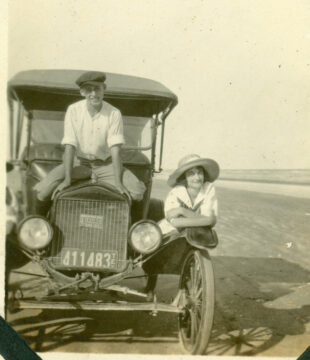
A casual stroll down The Strand or to the west end will reveal that cars are hardly the only vehicles on the road. Today golf carts, bikes, scooters, Segways and even horse-drawn carriages, all offer unique transportation options. If all goes according to plan, Galveston will soon have its trolleys back as well. But it turns out diverse transportation is not new to Galveston. Throughout its rich history, numerous vehicles have played an important role in the transportation of people and goods on the island. Drays, floats, single and two-horse wagons, and eventually automobiles all had to share the streets. Each had specific license plates that were mandated by the city. Some of these fascinating pieces of local history still survive today. Rosenberg Library was proud to display a portion of its vintage license plate collection including those for floats, drays, and early automobiles and related photos as the May Treasure of the Month.
Drays and Floats
Drays were simple, short two-wheeled mule drawn carts that had a wide body for stability. They did not have a seat, so the driver – called a drayman – perched himself atop his load. Typically draymen worked in teams of five with each cart carrying three bales of cotton. The team had the difficult task of loading cotton onto the drays from a railcar and then unloading it on a ship. This task was absolutely critical to the smooth function of the cotton and shipping industries.
By the mid-1880s improved farming techniques and increased exports eventually outpaced the draymen’s ability to keep up with demand for their services. Four-wheeled wagons called floats overtook the drays in the transportation of cotton. Floats were much larger and able to haul 10 bales of cotton in one load. However, the draymen kept their trade alive by hauling incoming merchandise from the wharves to storage facilities.

Early floats were designed to be pulled by two mules, but inclement weather and poor roads forced drivers to employ a third mule ahead of the others. This ‘spike’ arrangement, as it was called, was very difficult for drivers to control, so they switched to having all three abreast. The new arrangement, coupled with improved construction of the floats, made it possible to carry up to 15 bales of cotton in one trip thus drastically improving the efficiency in loading and unloading cotton.
By 1913 Galveston began to see yet another shift in transportation patterns with the rise of the motorized vehicle. Chris Murray, a reporter for the Daily News, mused
“How long [until the float is phased out]? It might be a decade; but surely will the historic, picturesque dray disappear from the streets of the Oleander City. The mule will haul his last load, cut his last caper and pass into oblivion with a final kick of his heels and a farewell bray…”

While he was off by a few decades, evident by the 1930s licenses plates for drays and wagons on display, Murray’s prediction turned out to be quite accurate.
Automobiles
The earliest automobile plate in the Library’s collection coincides with the creation of the Highway Commission in 1917. The commission was charged with mapping existing roads, hiring engineers, and developing a comprehensive plan for a new system of state highways. The law that established it also required that motorists register their vehicles. The cost was $3 for a motor cycle and ‘pleasure automobiles’ were charged $.35 per horsepower with a minimum fee of $7.50, while commercial vehicles were charged by the carrying capacity. Out-of-state visitors were required to purchase a $1 license if they stayed in Texas longer than ninety days.
These early motorists were required to prominently display a ‘license number plate’ (as they were called at the time) to the front and back of their automobile. Colors of the license plate changed every year to ensure drivers were up to date on their registration.
About the Collectors
The collection of license plates was donated by the estate of Mrs. Jean ‘Blondie’ Folse. Born in Kansas City, Missouri, Mrs. Folse earned a bachelor’s degree in English and a master’s degree in History from Kansas State University. She moved to Galveston with her husband Dr. Dean Folse when he became a teacher at UTMB. Dr. Folse taught at UTMB for over 30 years, and won numerous awards during his tenure. He was also an avid reader and noted stamp collector. Mrs. Folse maintained her passion for history throughout her life. She was a member of several historical societies.